Barnbougle Dunes Golf Links, Tasmania, Australia: A Review
by Matthew Mollica
October – December 2004
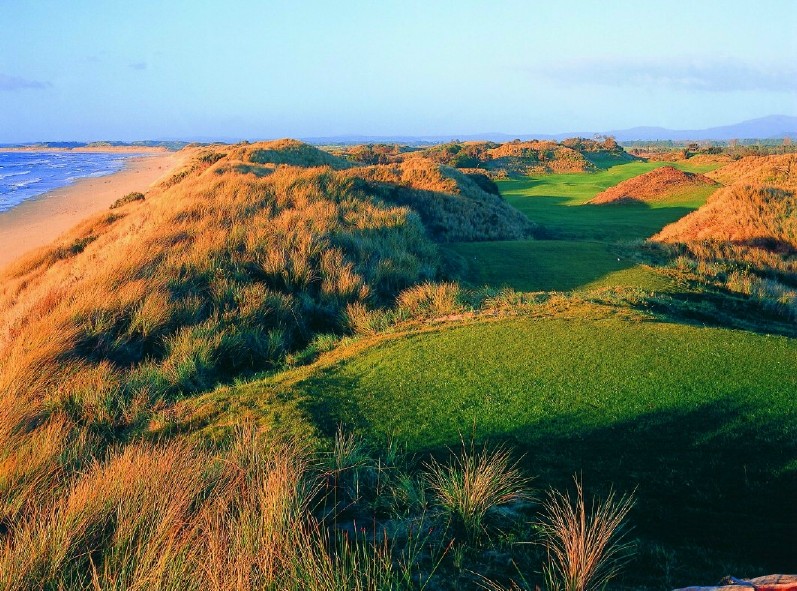
Barnbougle’s incomparable dunesland setting.
Saturday October 9 2004, will be remembered by many as the day on which John Howard was re-elected as Australian Prime Minister for an historic fourth term. It will be remembered vividly by this little black duck, as the day on which Barnbougle Dunes Golf Links opened for play, albeit unofficially. It was my first visit, I’ve been back since, and I hope there will be many more. Barnbougle Dunes (BD) is the collaborative design effort of Tom Doak and Mike Clayton. The course is located in the north-east corner of Tasmania, next to the quaint seaside town of Bridport, which snuggles neatly into the hillside, adjacent to the mouth of the Great Forester River. It is on windswept, corrugated, sandy dunes land that BD is located, between Bridport, and the river, hard against Bass Strait. The land was once the sole domain of local farmer Richard Sattler. The terrain is ideally suited to golf. The mix of stiff sea breezes, salty air, sand, and undulation is enough to make golf enthusiasts drool. The golfing fraternity both in Australia, and around the world, eagerly anticipated the opening of BD for years. News of the amazing site consistently percolated through internet forums devoted to golf and golf course architecture long before the course opened.
The mix of characters in the cast behind the realisation of Barnbougle is many and varied. Young visionary Greg Ramsay, a golf enthusiast from Tasmania, approached Richard Sattler many moons ago with a view to placing a golf course on his wonderfully suited land. Mike Keiser, financial driving force behind Bandon Dunes and Pacific Dunes, also played a part in Barnbougle Dunes. Tom Doak was given a leading hand in design and construction of the course. Tom secured the services of local like-minded architect Mike Clayton to work along side him. From a very early time in the round at Barnbougle Dunes, golfers are presented with the indisputable and alluring essence of true golf. If scientists could somehow figure a way to bring Dr. Alistair McKenzie back from the grave, I am sure he would congratulate Tom Doak for ‘a job well done laddie’.
On approaching the course site and surrounds, one instantly becomes aware of the strength and direction of the prevailing winds. Combating it will often be an essential part of safely navigating a way around BD, with strong coastal breezes quartering mainly from the West. The course is divided into two loops of nine. The opening nine essentially makes an out and back loop to the West, returning to the centrally located clubhouse. This path is punctuated by a single turn back into the west, in the form of the wonderful short par three seventh hole, but more on that later. The Eastern half of the site contains holes ten through eighteen, which wind along in much the same manner at those on the front side. Some play into the wind, and some with it. All the while, a lovely rhythm is preserved. The course boasts a par of 71. There are four sets of tees; from the back markers, the course measures 6141 metres. At the time of my initial visit, Barnbougle Dunes’ clubhouse, practice facilities and lodges were under construction. These facilities are now up and running, and the clubhouse is a wonderful place to chat and sip after a round. The views from the decking, over the sand and water, towards the setting sun, are breathtaking.
Barnbougle’s opening hole is a 506m par 5 with a slight dogleg right and a gentle uphill slope towards the green. It is played into the prevailing wind. As is the case with so many holes at BD, humps and hillocks are found within the sandy soil. Golfers are introduced to these at the drive landing zone of the first hole. This provides a variety of stances and shot making decisions, in keeping both with Doak’s philosophy on the way golf should be played, and the very nature of seaside play. Safely negotiating a path past right side fairway bunkering in close proximity to the second shot landing zone sees a relatively straight forward approach to an uncomplicated green devoid of sand traps. The wind plays a crucial influencing role on the first three shots of the day. The first green, like so many on the course, features wonderful internal movement completely consistent with the surrounds, providing enjoyable putting challenges, a multitude of short-game options, and wonderful aesthetics.
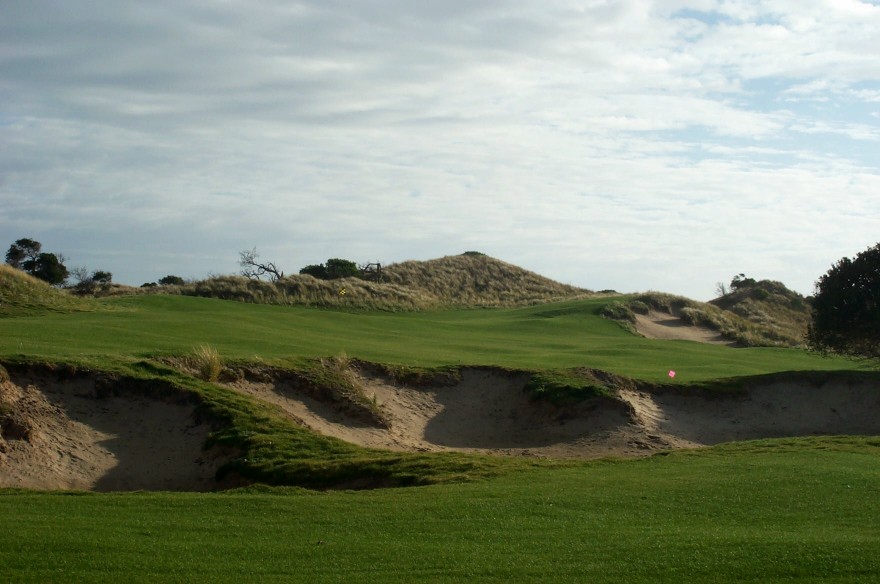
The low profile 1st green.
The second hole, a mid-length par 4, is also played into the prevailing breeze, and is on the flattest segment of the course. A small cluster of left side fairway traps can be negotiated to give a mid-iron second shot down the spine of a narrow yet deep green. Several plateaus and ridges exist within the putting surface, and steep fall-aways are seen left and right of the green. From here, the golfer quickly moves into exciting and inspiring dunes land. The shimmering marram grasses and small costal trees provide a wonderful backdrop, for the challenging holes that lay ahead.
Although relatively short at 339m, the par 4 third hole is a wonderful challenge. It is played to a partially blind fairway, over a tall oblique sandy ridge, covered with low growing coastal trees and shrubs. The far side of the hole features a stately old pine tree, and large sandy waste area, which are both out of play. Their role in navigation however is quite important. The hole features a wonderful hourglass shaped green, blind from the tee, with greenside bunkering found left and right of the putting surface. The back two thirds of the putting surface slopes gently from front to back, with much of the putting surface tilted left to right. When blazing towards the sandy waste area with driver, and aiming for the haven of the wider left half of the fairway, one is able to pitch to the rear half of the green without too much difficulty. Playing from the left half of the fairway to a front pin position however is more difficult, with both greenside traps coming into play. Any pin cut on the front half is best accessed through an approach made from the right half of the fairway. A central fairway bunker approximately 40 metres short of the green will pose small problems for the drives of very long hitters. For the majority of golfers this sand trap creates some depth perception problems as it obscures a zone of dead ground measuring tens of metres between it and the green apron.
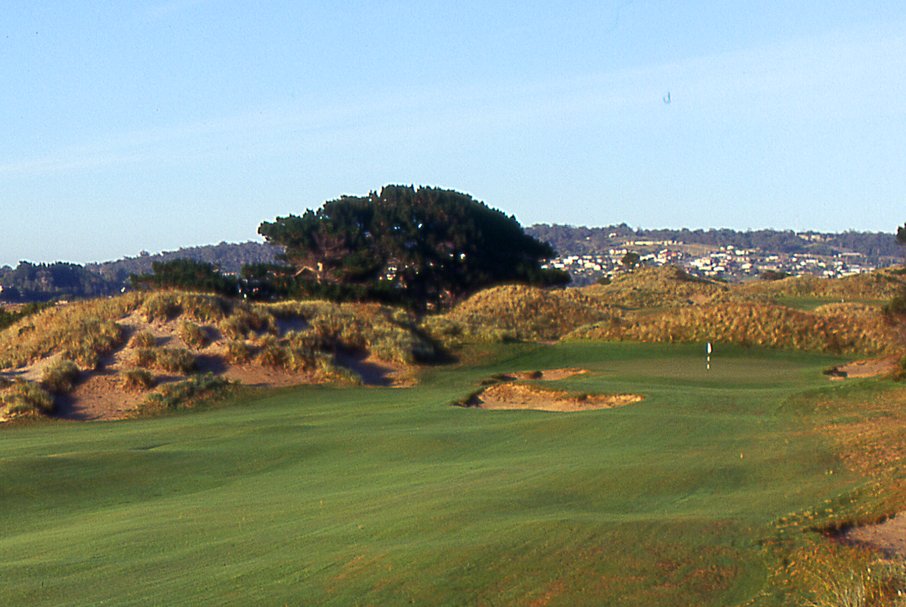
The short bunker creates depth perception problems at the 3rd.
The walk from the third green to the fourth tee is sure to excite. Upon nearing the teeing ground, the golfer is confronted by a massive expanse of sand located on the direct line from the fourth tee to the fourth green. The size of this bunker is comparable to that of Hell Bunker on the 14th at St. Andrews Old. At 271m, BD’s par 4 fourth hole provides the golfer with many options from the tee. Like the third, this hole will often play directly into the wind. From an elevated tee, one may play safely to the expansive valley below, laying up prior to the sand trap. Or, one may elect to hit a longer ball to a thin fairway segment left of the hazard, or alternatively attempt to carry the sand and play for the green. The reward for achieving the heroic bunker carry from the tee is either an unimpeded view of the green with a very short, straightforward chip, or an eagle putt. Recovery from the sand is very difficult, as one would expect. Playing safe from the tee, landing short of the massive fairway bunker, sees the golfer play a blind second over the intimidating trap to an elevated green site, with a wonderfully constructed putting surface. The elbow of a small marram covered dune abuts the boomerang shaped green. The back portion of the green veers at literally 90 degrees to the left, with pins cut on this portion, behind the marram-covered dune, providing a challenging approach.
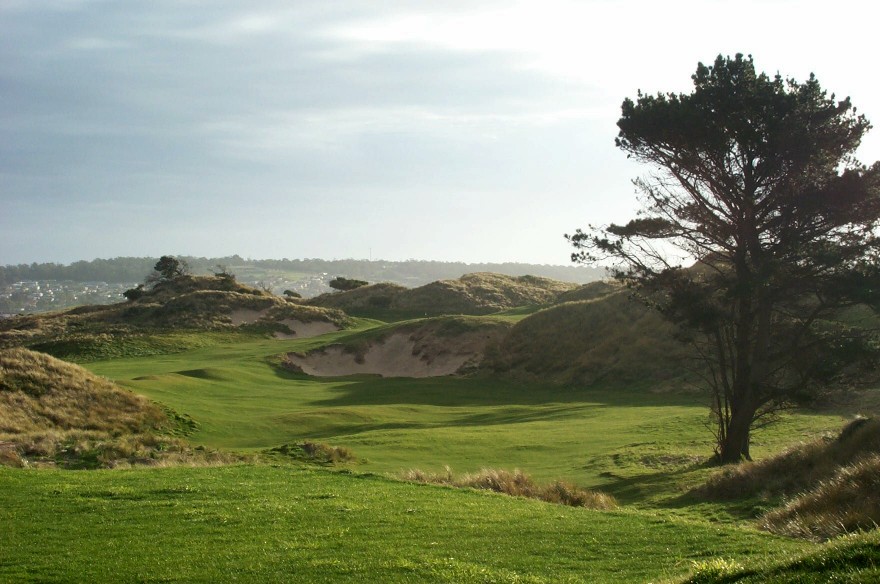
The golfer can’t fail but be inspired at the glorious 4th.
The walk from the fourth green to the fifth tee takes the golfer on a beach side path measuring several hundred metres. Views of the town of Bridport, as well as the barren beach, and turquoise waters of Bass Strait are absolutely stunning. On reaching the 200m par 3 fifth hole the golfer might be comforted by their first sensation of a trailing breeze. From an elevated tee, play is directed to a large and unbunkered putting surface below. A diagonal ridge from top left to bottom right will influence many putts, while a grand dune short and right of the green obscures a significant segment of the putting surface, making for interesting play to a flag at the front right green quadrant. This putting surface is the first of many that features considerable internal movement.
The sixth hole is a testing par 4, measuring 381m. It will usually be played with a trailing wind. The fairway features a large solitary sand dune at its right side. One may elect to play safely away from the dune, to an expansive landing zone on the left side of the fairway. The approach is more difficult from this side however. The alternative is to fade a long iron, fairway wood or driver, around the solitary dune, towards the ideal landing zone at the right half of the fairway. From this point an uphill approach (short iron or wedge) is played to another bunkerless green, with appreciable back to front tilt. The sixth is another of many delightful holes found on BD where the approach is played from a relatively sheltered valley, yet the ball is affected by strong winds above, to which the golfer playing his stroke may be oblivious. Correct club selection is an important factor when approaching the sixth.
The seventh hole, named ‘Tom’s little devil’ turns back to the west. At 110m this par 3 may not appear to pose much of a problem to golfers reading yardages from the card. Played into the prevailing breeze, and featuring a small green guarded by cavernous bunkers at its left side, this hole is anything but sedate. The strategy of playing a controlled low shot with an extra club is more often than not the play of choice into the wind. Holding the putting surface with a trailing breeze is perhaps even more challenging. Avoiding the left greenside traps at all costs is a smart move as they are so deep, that golfers tending the flag are unlikely see their playing partners within the steep greenside traps, less than ten metres away. A testing pitch and putt for par from the bailout zone short and right of the green is a more desirable option than playing a second from the sand. This hole is sure to provide some headaches, and from time to time, will ruin a good score amassed after the first six holes. Strong local winds have already seen some golfers hit three iron to this green!
Turning for the clubhouse, golfers play the eighth and ninth with a prevailing breeze helping. The appearance of rough ground in the centre of the fairway on the 446m eighth hole will disconcert some. The unkempt nature of this swathe of grass essentially divides the fairway into left and right landing zones, with a high road and a low road from which to choose. Approaches to the green are perhaps best played from the higher left side of the fairway, which is harder to access from the tee. This region affords a better look at the green, but is undulating in parts, providing uneven stances and tough shots for some. Even with all this in mind, safely executing the tee shot to the short grass is less than half the challenge on this hole. Playing up towards the relatively flat and partially obscured green complex, one must traverse a considerable deal of trouble. Rough grass and broken ground lies on an upslope between fairway and the green fringe. Despite the assistance of a tailwind, this shot is perhaps the most intimidating on the course, even with ample bail out area short and left of the green. Par saves from this zone may be quite difficult, owing to the subtle movement within the green. Similar difficulties are encountered attempting a par save from the solitary right side greenside bunker.
The ninth hole is played in the same direction as the eighth, and is another difficult 400 metre par 4. The tee ball is played from one plateau to the next, with several humps and hollows found in the landing zone for balls played with long irons. The blind landing zone for fairway woods and drivers is complicated by undulating ground, unkempt grass, and rough marram grasses planted in asymmetrical patterns and on irregular diagonals. Taking driver on this long hole, particularly with a strong helping breeze, the golfer needs to commit to a stroke down the left side of the hole with much of the ball flight carrying deep rough. Even upon executing such a heroic shot, the reward for this play may not be proportionately high. Golfers having hit a well struck driver, play a very short second club into the green, yet may have an uneven stance, and may even face a semi-blind shot. Hanging back from the tee with a long iron (or even mid-iron in some winds) obviously yields a longer second, yet full visibility of the green is afforded from this playing zone, and little is risked from the tee. Perhaps the ninth hole is a statement made by the designers, that prudent placement is sometimes more preferable than power.
Moving beyond the clubhouse to the eastern half of the property, the 409m par 4 tenth hole provides a wonderful driving challenge. An expansive fairway up to 60 metres wide in parts invites golfers to open their shoulders. The hole bends gently to the left; an uphill second shot is played to an undulating skyline green, free from any sand traps. The putting surface slopes considerably from back to front, and also contains several plateaus, rewarding accurate approach play. The par 5 475m eleventh hole is played in the same direction as the tenth, (usually down wind) and is one of the easier holes on the course. It is a joy to behold, with its wonderfully wide and undulating fairway, asking each golfer to navigate their own course to the flag. Accomplished golfers would expect to reach the green in two, and in doing so, consider a solitary left greenside bunker. A steep longitudinal ridge divides the very large putting surface; there will be many three putts from the wrong side of this spine. Those playing the hole conservatively will find little difficulty in playing three measured strokes to the putting surface, with a birdie chance perhaps beckoning still.
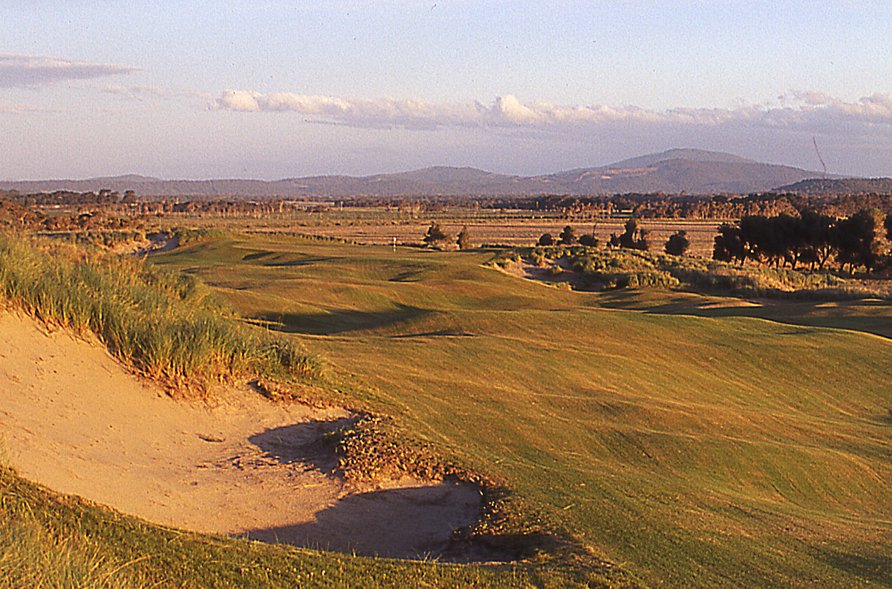
The undulating 11th fairway provides great golf quality.
The 250m par 4 twelfth plays slightly uphill and doglegs ever so slightly to the right. This is another in the series of excellent short par fours at Barnbougle Dunes. Called Temptation, the twelfth will provide just that for big hitters. Direct lines from tee to green require an uphill carry of more than 200m, often into the wind, over considerable quantities of broken ground and rough marram grasses, with the slope heading away from the green, and rendering recovery most difficult. The safe play down the left half of the hole, sees an easily reached fairway, but an awkward little chip to a small, contoured putting surface. A knoll situated centrally in the fairway, twenty-five metres short of the green surface, makes the putting surface appear closer than it actually is. A solitary bunker located behind the green catches overcooked approaches.
The thirteenth hole is the first of the par threes on the second nine. Measuring 181 metres, this hole is yet another that will take the players’ breath away. Featuring a beautifully situated green site, and a wildly contoured, expansive putting surface, this hole will be sure to generate discussion and debate. Several informal bunkers and sandy waste areas provide left, right and rear definition to what is no doubt one of the most heavily contoured greens on earth. It has been inspired by the green belonging to the short hole at Sitwell Park, as described in Dr. Alister MacKenzie’s text, The Spirit of St. Andrews. It’s humps and hollows are reminiscent of the Himalayas found at St. Andrews, but possibly more pronounced! Selecting the appropriate club, given hole location and wind strength, is a small fraction of the battle in tackling this hole. Birdie, par and bogie putts are all sure to provide plenty of excitement and thrills on the 13th at BD.
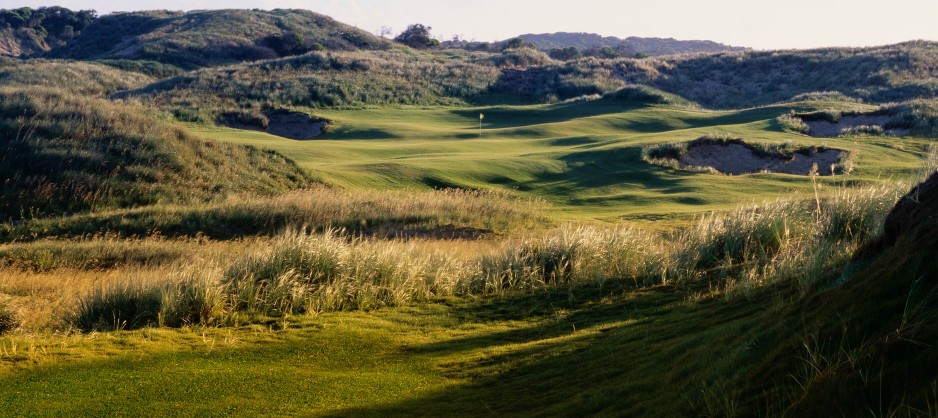
The natural one shot 13th.
The last of the par fives, the 508m fourteenth hole, sees the golfer drive to a fairway that gently slides from left to right, and is partially obscured. Apart from the slightly awkward drive, the hole asks the player to negotiate a narrow second shot landing zone, which doglegs back to the left and features hills and hummocks which may deflect the ball or complicate stance and lie. Add to this a smallish, well-guarded green, featuring smartly placed left greenside bunkers, and the par five double dogleg fourteenth is a very solid hole. After putting out, golfers then make the turn for home. Play on the fifteenth through eighteenth holes will often be met with head winds. Although still featuring plenty of undulation and dunes, this segment of the course provides little shelter from the elements. Consequently, the wind’s effect on ball, stroke and player alike are pronounced in the closing stretch.

The 14th green offers numerous interesting hole locations.
The fifteenth hole bends ever so gently from left to right and allows golfers on the tee to visualise a bunker complex relatively centrally located within the driver landing zone. A sliver of fairway sneakily located to the right, and unsighted from the black tee, affords some respite for the slicing golfer. Another well-contoured green featuring deflective mounds and slopes requires an accurate, well struck approach. Lobs, chips, pitches, and bump and run shots are all able to be played as third shot recoveries from short, left, and right of the fifteenth green. The sixteenth hole, the final par three of the course, measures 142m. Another expansive putting surface waits at the far end of the hole, with skilful players able to use feeding slopes at the left side of the putting surface to their advantage in approaching many pin positions. The front left quadrant of the green is partially obscured when play is made from the yellow tee. The small sand dune responsible for this visual disturbance plays a much greater role for those hitting from the black markers. Set a little lower and to the left, the shot from this teeing ground is virtually blind.
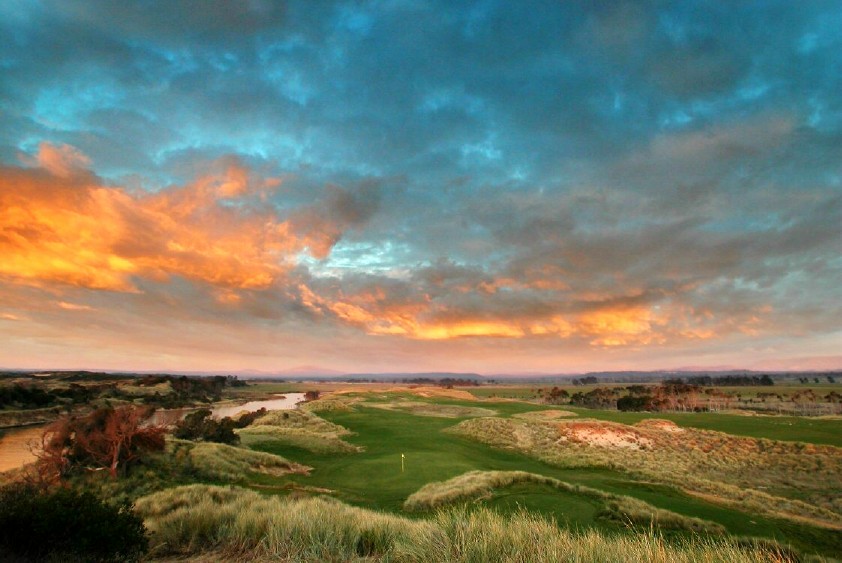
The unspoilt landscape as seen from behind the 16th.
The final two holes at BD are 400 metre par fours and will most likely become recognised as Australia’s toughest consecutive par fours, and perhaps Australia’s toughest closing pair, when the prevailing wind is in. The seventeenth hole bends gently from left to right, and prevailing winds demand that the golfer play a ball which starts out right, aimed away from the fairway, almost towards the beach. Prevailing winds will nearly always see such a ball blown back into the field of play. The approach can play long, into a small green featuring a steep drop off and collection area to the left. Run up approaches to the right half of this green are possible. A chip for three from the flat area short of the green is a far more desirable proposition than recovery from pin high and left of the putting surface. The final hole is also nestled against the beach, and will be a truly beautiful arena for play late in the day. Like the seventeenth hole, the last also demands two solid strokes, in order to find the putting surface. A low strong ball flight is required off the tee and into the green. The eighteenth green is yet another very well contoured putting surface, with approaches finishing short and right leaving the golfer to negotiate interesting ridges and swails on the way to the cup.

The thrilling 17th with the clubhouse now in sight.
For a nation boasting a myriad of wonderful golf courses designed by some of golf architecture’s most respected names, it is difficult to believe that only now does Australia possess a truly magnificent seaside course. Situated immediately adjacent to the rolling waves of Bass Strait, Barnbougle Dunes’ position is ideal. It is a course of rare quality with hole after hole providing challenge, enjoyment, demanding shot making, and reward for sound strategy. The course embodies so much of what true golf is about. BD will no doubt ascend to a position in the very upper echelon of Australian courses, and by definition must surely be ranked among the top 25 courses in the world. Asking playing partners to nominate their favourite hole will almost always see a reply mentioning five or six holes. The idyllic beauty of the landscape and the majestic hues of land, sea and sky will leave an indelible mark in the memory of all golfers who visit BD.
Points worthy of particular mention in any discussion on the design merits of Barnbougle Dunes include the oblique nature of many tee shots, both to fairway landing zones, and in regard to wind directions. The perfectly situated green sites are numerous. Similarly, the putting surfaces appear to meld beautifully with the terrain, almost as if Doak and Clayton had laid eighteen blankets of fine fescue down upon the mounds that lay there for centuries prior to opening the golf course. The egalitarian nature of the course is a point worthy of consideration. The voracity of the wind appears to have been ever present in the minds of the architects during course design, both in terms of length, and the green surrounds. Rather than adopt an overtly penal nature, with a plethora of bunkers, Doak, Clayton and company have elected to demand a myriad of recovery strokes from golfers who fail to reach greens in regulation. Plantings on the course are in harmony with the locale, with fescues found predominantly through fairways and greens. In firm conditions, and best presentation mowing heights, the course will be a delight to play for those who revel in traditional firm turf conditions.
Few would doubt the bravery of Ramsay, Keiser, Sattler and their team in conceiving Barnbougle Dunes. The course is a long way from any population centre of significance, and sees all mainland residents of Australia taking a flight or boat, then a car trip, to get to the course. No doubt all who visit Barnbougle Dunes will applaud the wisdom of appointing Doak and Clayton to design the course. The efforts of all these men are to be celebrated; they have collectively delivered one of the finest golf courses in Australia, and a must-see course for anyone who takes golf seriously. Playing Barnbougle Dunes is a delightful experience. Those travelling to Tasmania, and completing the hour’s drive from Launceston to Bridport are ensuring themselves of one of the great golfing pleasures on earth.
The End







